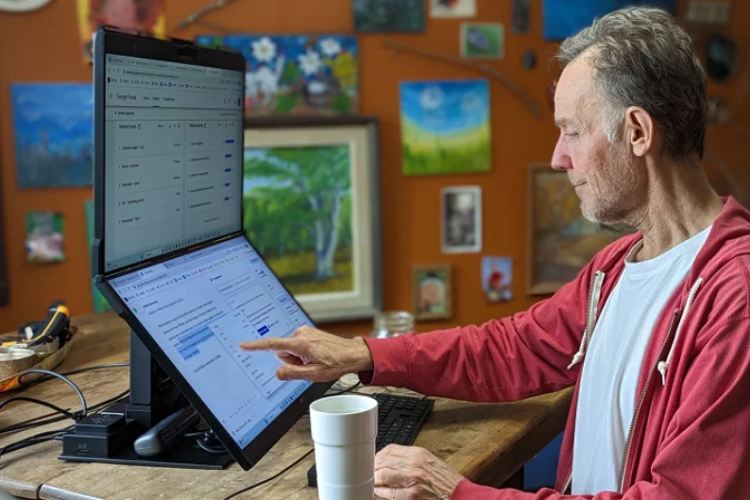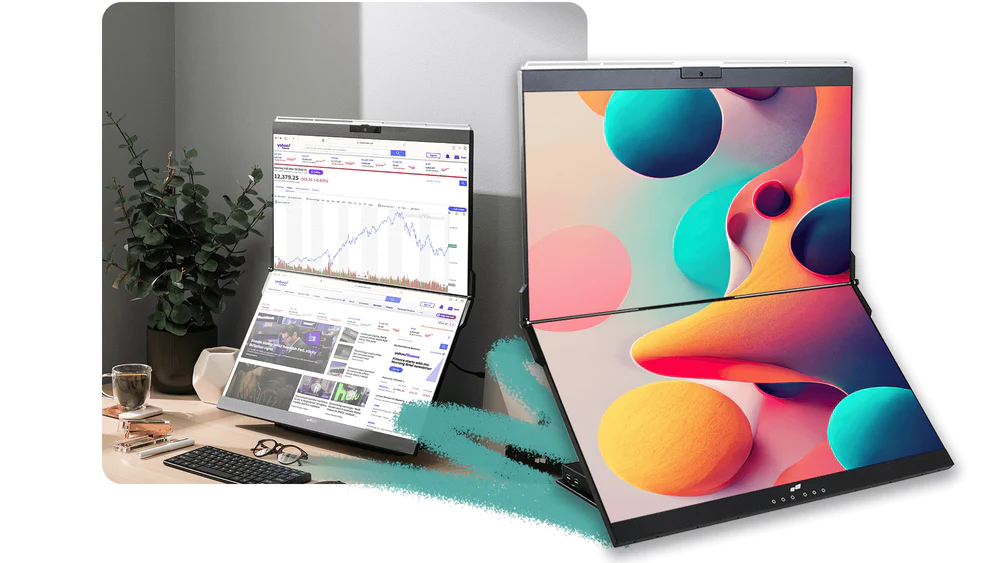Maximizing Productivity with Stacked Monitors
Stacked monitors offer an exciting avenue to boost productivity and gain unique insights. This article delves deep into the significance of stacked monitors in data analysis and visualization. It provides several advantages over single-screen setups when it comes to data analysis and visualization tasks.
Data analysis, which helps you make smarter decisions, is a complicated process. And we don’t say this lightly.
It calls for applying various tried-and-true techniques and tools like machine learning and artificial intelligence to inspect data, observe trends and patterns, and find and improve areas of weakness. These are all designed to positively impact your KPIs, no matter your industry.
All this from quantitative data—no wonder it’s a high-demand and highly-valued skill.
But, with over 93,471 data analysts in the U.S. alone (and not counting ones who work for American businesses remotely), it can take a lot of work to prove your skills in the industry. This is precisely why you need Geminos stacked monitors.

The Role of Stacked Monitors in Data Analysis and Visualization
Stacking multiple displays provides many benefits when performing tasks related to analyzing complex datasets or generating visuals from them. Here are some key aspects of their role:
1. Multiple screen systems
Stacked monitors provide better ergonomics than traditional single-monitor setups. Users do not have to strain themselves turning back-and-forth between different displays. The ability easily moves windowed components up/down/left/right across. Several screens allow analysts greater flexibility when creating visualizations, organizing workspaces more efficiently, etc. Something especially helpful for those who may not necessarily have physical space available to accommodate extra computer desks. But still want to benefit from increased productivity associated with using multiple screen systems.
2. Multitasking Capabilities
One of the biggest advantages that come with stacked monitor setups is improved multitasking capabilities when it comes to working with large datasets or complex visualizations. With multiple screens, you can have several applications open simultaneously without having them overlap with one another. It allows you to quickly switch between tasks without any disruption or loss of focus due to time wasted navigating windows around your desktop space.
Additionally, as many modern displays come equipped with high-resolution panels they are perfect for displaying multiple graphs/charts/images at once. It allows users to compare different visuals simultaneously. So, users can improve workflows & efficiencies associated with analyzing & interpreting large amounts of data sets quickly & accurately.
3. Enhanced Data Exploration
With a single monitor setup, it is difficult to explore large datasets due to limited screen real estate; however, with two or more screens side-by-side (or even above one another), users are able visualize larger datasets without having them split across different windows or tabs on the same display. This allows for better comparisons between variables as well as improved discovery capabilities since all relevant information is visible at once instead of needing constant scrolling back and forth between different views on one screen.
4. Comparative Analysis
Stacked monitors make comparative analysis easier by allowing users to compare different parameters simultaneously rather than having to switch back and forth between different windows or tabs as they might have done with just one display unit. This makes it much easier to find correlations between variables because all that is needed for comparison will be there. Stay there within easy reach rather than scattered across multiple windows/tabs, otherwise the connection may be lost.
5. Interactive Dashboard
Tacked multi-monitor setups enable interactive dashboards that display live updates from sources such as databases, web services, etc. Thus, a detailed overview of specific time period as well as in-depth analysis into user behavior and market trends is provided. Such rich visualizations not only look great but also improve engagement and understanding among the stakeholders involved in making decisions faster and effectively.
6. Flexible Configuration
Stacked monitor configurations allow users to customize their workspace according to their individual needs – including size, resolution, orientation (landscape/portrait), etc. This allows them to prepare setups while also being able to perform specific tasks such as coding or designing graphics. Access other tools with minimal effort by simply transferring focus from one screen to another without requiring any additional hardware configuration changes.
7. Reduction in Mental Fatigue
Having all relevant information available simultaneously reduces cognitive load when performing complex analyzes because users do not need to waste time switching context between different windows – resulting in greater productivity over time. Additionally, this type of arrangement eliminates the need for eye strain from viewing great distances, which often causes headaches and eye strain after staring at a computer screen for long periods of time.
8. Adaptability to Different Devices
By using stacked displays, individuals are better equipped to manage the various software packages used within the field. Due to flexibility, it accommodates both vertical and horizontal orientations depending on the work requirements. For example, if someone is trying out code they may use landscape layout while portrait will come in handy when dealing with large spreadsheets with many columns and rows; Thus, allowing the user to make the most of every tool available, no matter what format it is presented in!
How Can Stacked Monitors Help You Excel in Your Career?
Stacked monitors increase your available screen space exponentially, but many people don’t understand just how big an impact that makes.
Laptop screen sizes are pretty much standardized, around 13” to 15. But with this expanded setup, you get two 24-inch 1080p full HD displays. Think about the possibilities!
With all that screen real estate at your fingertips, you can open and run multiple programs, documents, and datasets simultaneously. By giving you more space for data visualization, it eliminates the need to toggle between tabs, windows, and apps.
Studies have shown that switching back and forth between digital assets can cost an average of 9 minutes and 30 seconds to get back into a productive workflow. This is why stacked monitors can be the game-changing accessory that sets up the most nimble mind for success—you can easily work on multiple documents at maximum efficiency and convenience.
Is Extra Screen Space Reason Enough to Invest in It?
Do you want to make your work life easier? Then yes, you will significantly benefit from this fantastic monitor, which is guaranteed to exceed all your expectations.
As for how it can create magic in your workflow, it boils down to how you use it.
Do You Enjoy Multitasking? Does Your Work Require It?
Many people believe you can get more done by doing less—this is backed by studies. Instead of dividing your attention between multiple tasks, it’s best to focus on just one. Otherwise, you’ll be more distracted, making you much more susceptible to errors.
However, this research doesn’t account for multi-monitor setups.
Data analysts will benefit from stacked monitors, even for simple tasks like side-by-side comparisons. As there’s enough space for all essential files and tools, you can maintain a productive work environment without resizing windows and flipping between tabs.
You can use one screen to extract the information required or create narratives with data and use the extensions to develop and beta-run systems that make data collection a breeze. And you can do so without distractions, thanks to its ultra-thin bezel design that allows for a more immersive experience.
Do You Work Alone or In Groups?
Data analysts often work in teams and groups. Even when they conduct research on their own, they must report their findings to others throughout the hierarchy to brainstorm ways to use data to their advantage.
Luckily, stacked monitors facilitate a seamless flow of information by giving an extra screen. This means you can showcase your ideas to your teammates and make changes in real-time while maintaining the visibility of the data you’re sharing.
There’s no minimizing or maximizing windows. No wonder it boosts productivity!
Do You Want To Improve Your Working Conditions?
Many oppose the idea of switching to a multi-monitor setup because they believe it will take up too much desk space. While valid, it’s not a concern you face with stacked monitors, as they are, yes, stacked on top of each other.
This means you can use it to expand your working space without increasing your desk footprint. With features like a built-in webcam, speakers, and microphone, it further frees up available space, setting you up for a more productive work environment.

Let’s Not Forget the Most Obvious Benefit: Ergonomics
This stacked monitor system has infinitely adjustable angles, so you are sure to be comfortable.
Keep it at eye level, at least an arm’s distance away, then slide the top screen up or down to maintain an ideal posture. This will reduce musculoskeletal concerns as well as eye strain and fatigue!
Conclusion
The role of stacked monitors in data analysis and visualization is to create a more efficient, flexible, and collaborative working environment. This enhanced workspace empowers analysts to explore, analyze, and interpret data with greater ease and precision, ultimately leading to more informed decision-making processes.
If you’re a data analyst looking to make your work life easier, stacked monitors will treat you well. Discover the full range of its features by visiting our website today!



